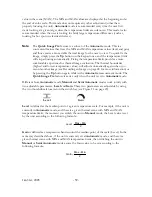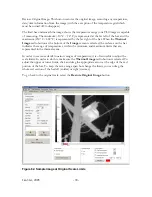
Emissivity
Emissivity is the measure of an object's ability to emit infrared energy. Emitted infrared
energy is exponentially proportional to the temperature of the object. Emissivity can have a
value from 0 (shiny mirror, perfect reflector) to 1.0 (blackbody, perfect emitter). Most
organic, painted, or oxidized surfaces have emissivity values close to 0.95. If you are
performing qualitative inspections with your imager, leave the emissivity set at 1.0. If you
need to measure actual temperature values, set the emissivity value according to the
emissivity of the material the object you are measuring is made of. Again, if you need
accuracy, you will need to find the emissivity value of the material before taking the
measurement. See Table 1 on page 89 and Table 2 on page 90 for the emissivity values for
the most common materials.
There are a couple of methods that help you to find the emissivity value of materials:
•
Tape method:
this method requires the usage of the Scotch
®
brand PVC tape
(emissivity value 0.97) or equivalent. Cover the surface you want to measure with tape.
Wait some seconds for the temperature to stabilize. Set the emissivity of the imager at
0.97 and measure the temperature. Make a note of the temperature value. Then, remove
the tape and measure the new temperature value. Adjust the emissivity accordingly until
the temperature value found previously is displayed on the unit. This emissivity value is
the one of the material being measured. This method is good for objects that are at low
temperatures (under 100
°
C (212
°
F)), not electrically energized and not in motion.
•
Contact thermometer method:
this method will need a contact probe and good quality
temperature meter. Initially, use the contact probe temperature meter to measure the
temperature of the object you want to know the emissivity value, allowing time for the
contact probe to stabilize (this may take up to a minute). Make a note of the temperature
value. Adjust the emissivity on the imager accordingly until the temperature value found
previously with contact probe temperature meter is displayed on the imager display. This
emissivity value is the one of the material being measured. This method is good for
objects that are at moderately high temperatures (under 250
°
C (482
°
F)), not electrically
energized and not in motion.
To set or change the
Emissivity
value, complete the following:
1. Put the Ti30 imager in regular
Measurement
mode.
2. Press the
MODE
button once. At this point you will be able to adjust
Emissivity
.
3. Set the
Emissivity
value to the proper value, according to the target material, by
pressing the
Up
and
Down
buttons.
Reflected Temperature Compensation
Targets that have low emissivities will reflect energy from nearby objects. This additional
reflected energy is added to target’s own emitted energy and may result in inaccurate
readings (see 58 below). In some situations objects near the target (machines, furnaces, or
Jan 31st, 2005
- 65 -
Summary of Contents for Ti30
Page 4: ...Appendix B Infrared Theory Q A 92 Glossary 96 Jan 31st 2005 4 ...
Page 25: ...Man Machine Interface Flow Charts Main Loop Jan 31st 2005 25 ...
Page 26: ...Image Recording Procedure Emissivity Adjustment Procedure Jan 31st 2005 26 ...
Page 70: ...Jan 31st 2005 70 ...
Page 86: ...Jan 31st 2005 86 ...
















































